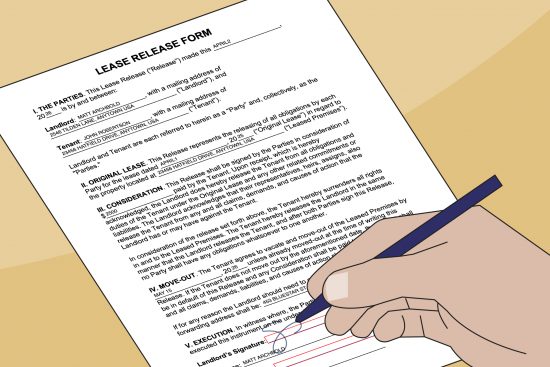An early termination lease letter is written to a landlord to request termination and release from a binding lease agreement. This can be due to a number of factors such as unemployment, job transfer, or other economic factors. Technically, a landlord does not have to release a tenant from their agreement, although, rather than face a lengthy eviction process, most landlords are open to terminating a lease in exchange for forfeiture of the security deposit.
When Sending – It’s recommended to send an early termination letter by Certified Mail with a return receipt.
How to GET OUT of a Lease (4 steps)
The process varies for each landlord and depends on the amount of risk a tenant would like to take. In most cases, the tenant will have to pay one (1) month’s rent which is usually taken from the security deposit being held with the landlord.
Step 1 – Contact the Landlord

Send an early termination lease notice and try to make it an emotional and heartfelt letter, much more than just stating the reason to vacate. Try to create a sense of urgency that there is no way the lease can continue on its current terms.
Try to provide as many options available such as:
- Offering a cash payment to be released (such as forfeiting the security deposit);
- Request to sublet the premises; or
- Request to put the property up for lease and to pay rent until a new tenant is found.
Step 2 – Negotiate the Terms (2 options)

If the landlord responds, the tenant can negotiate the best terms available under the circumstances.
If the landlord does not respond, the tenant should take appropriate measures based on the amount of risk they would like to take. No matter what, the tenant should not pay the next month’s rent.
- Option 1 (lower risk) – Respond again to the landlord and try to get released from the lease agreement. At this point, the landlord will have their attention that the request is serious as rent is not paid. Hopefully, the landlord will negotiate based on not wanting to go through an eviction process.
- Option 2 (elevated risk) – Stop paying rent and reveal that if a release is not made that the property will be vacated anyway. The landlord will have the right to sue the tenant for damages, (i.e. for the unpaid months of rent) and will have to find a new tenant for the property.
- Option 3 (high risk) – Stop paying rent and threat that if a release is not made that the landlord will have to face a 60-90 day eviction process. This is not a recommended route and is to only be used as a threat. If a tenant is evicted they it will be placed on their personal history for seven (7) years.
Step 3 – Sign a Release

After negotiating with the landlord it will be time for the landlord and tenant to put it in writing. Whatever the terms of a release it should be made in written form (lease release form) and attached to the original lease agreement.
Step 4 – Move-out

After the release is signed the tenant should move out immediately. At this time, the lease has been terminated and the tenant is free to vacate the premises with no harm that can be done to their credit or public history.
